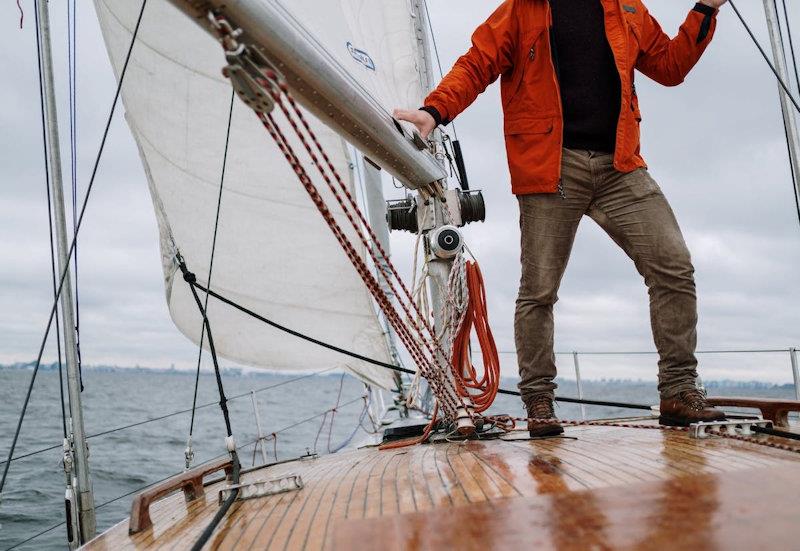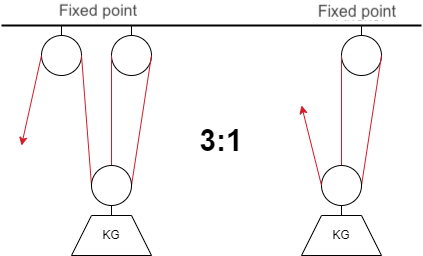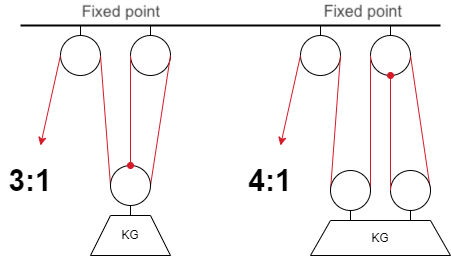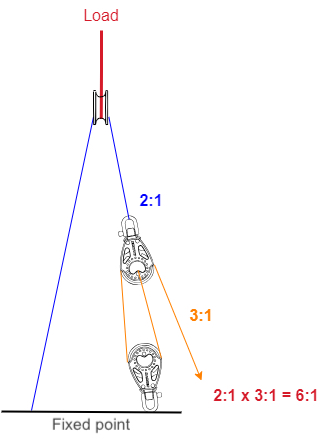
Block and tackle - understanding mechanical advantage on sailing boats by Upffront.com
by Calanach Finlayson 23 Nov 2023 12:00 UTC

A rough guide to purchase systems © upffront.com
A block and tackle or 'purchase' system is a form of mechanical advantage, where the input force is multiplied through a series of pulleys or blocks to create a much larger output force.
Trying to understand how to achieve different purchase ratios might seem daunting to the uninitiated, but it's quite straightforward once you know some basic principles. In this article we will guide you through different purchase systems used on modern sailboats.
Block and tackle: mechanical advantage or purchase?
A dictionary definition of mechanical advantage states: "Mechanical advantage is a measure of how much a force is increased by using a tool or machine. It is equal to the force exerted by the tool or machine divided by the applied effort".
In other words: output force = input force x mechanical advantage
Mechanical advantage exists in all kinds of machines from a simple lever to a complex gearbox. A winch on a sailing boat has a stated mechanical advantage, also known as power ratio. For example, a size 40 winch multiplies the input force 40 times. Therefore, applying just 10kg to the winch handle on your size 40 jib sheet winch allows you to pull 400kg on the sheet.
Similarly, a 4:1 vang system multiplies your input force by 4. In sailing, the mechanical advantage of a rope and pulley system is typically referred to as 'purchase'.
Creating purchase in the mainsheet system
For this discussion we will borrow some terminology from the world of climbing: simple system and compound system.
1. Simple purchase system
In a simple system, commonly referred to as a 'block and tackle', a single line runs through the entire system. The number of times the line runs between the blocks determines the number of purchases.
The purchase ratio of a block and tackle setup like this can be easily determined by counting the number of rope passes between the fixed point and the load. A couple of basic principles that may be useful to consider:
a) If the line that you are pulling comes from a pulley on the fixed point instead of the load, this is just a change in direction. The purchase is the same if you remove that pulley and pull directly from the load.

b) If the rope used in the system is terminated (spliced or knotted) on the load, the purchase will be an odd number (1:1, 3:1, 5:1 etc). If the rope is terminated on the fixed point, the purchase will be an even number (e.g. 2:1, 4:1, 6:1 etc).

Benefits of a simple purchase system:
- Simple to rig and easy to understand
- Requires only one connection at the fixed point
- Good for applications where the amount of adjustment is small
Drawbacks of simple purchase system:
- The amount of line needed is directly proportional to the amount of purchase so a 4:1 system requires twice as much rope as a 2:1 system
- Additionally, you are limited by the number of pulley sheaves that you can squeeze into each end. The below image shows the complexity of the blocks needed for the Harken 12:1 mainsheet setup for performance catamarans like the Nacra 17
2. Compound purchase system
A compound system is where one simple system is connected to the end of another. Any number of simple systems can be added together in this way. In this case, the resulting purchase is the multiple of the two simple systems. So, a 4:1 block and tackle connected to the end of another 4:1 provides a 16:1 purchase.
One of the most common ways in which compound systems are used in sailing is with one or more cascades. A cascade is simply a 2:1 purchase created with a single block or friction ring, onto which additional cascades or a block and tackle system are connected. Each cascade in this setup adds another factor of 2 to the total purchase.

The great benefit of adding cascades is to double the purchase without doubling the amount of line needed.
Another example of a compound purchase system is the coarse tune / fine-tune arrangement commonly found on sportsboat mainsheets, backstays and other control lines. The following image shows the Farr 30 cockpit layout from Harken. Can you work out the purchase ratios of the backstay and mainsheet? Let's look at this example of a compound purchase system on a Farr30 in detail:
Backstay purchase system
Two cascades each provide 2:1 purchase. A further 4:1 purchase is connected onto the second cascade. Therefore, we have 2:1 x 2:1 x 4:1 = 16:1.
Mainsheet purchase system
This is a classic coarse / fine-tune setup. The blue line runs through a double ended 6:1 purchase, providing the coarse 6:1 at the swivel cleat in the centre of the cockpit. The yellow line runs through an additional 4:1 which is connected to the other end of the blue 6:1. The resulting 24:1 fine tune control can be trimmed from either side of the cockpit.
Conclusions
Understanding how to create different purchase ratios is a useful skill when you consider modifying or upgrading any of the control lines on your boat. A simple block and tackle system is easy to implement and suitable for a wide range of applications up to approx. 8:1 or 12:1 purchase.
However, in situations where greater purchase is needed, some kind of compound system might provide the answer. A cascade can double the power of a purchase system with minimal extra line. In the same manner, adding a fine tune purchase to one end of a coarse tune creates a system with both speed and power.
If you have any questions about mainsheet purchase systems or need help choosing one of the products on our website, please feel free to email us at to talk to one of our experts.
Follow the link below to explore a variety of blocks available in our shop, the vast majority of which can be used in purchase systems:
